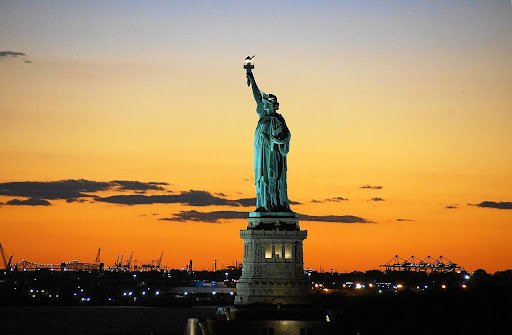Immigration and the War in Ukraine

As the Russian war on Ukraine drags on, many Ukrainian refugees seek temporary protected status (TPS) in the United States. Here’s a look at the past, present, and future of U.S. refugee and immigration law, focusing on the current conflict in Ukraine and war refugees.
A Brief History of U.S. Immigration Laws and Refugee Policies
The U.S. has regulated immigration since its infancy. Here’s a quick look at the evolution of America’s immigration laws and a lead-up to modern refugee policies that immigration lawyers practice today.

- The 1790 Naturalization Act excluded non-white people from the naturalization process. It required two years of U.S. residence, good moral character, and the applicant to be a free white person. In 1795, Congress extended the residence requirement to five years, then to 14 years in 1798. In 1802 Congress returned it to five years.
- The Naturalization Act of 1870 extended the right of U.S. citizenship to those of African origins and African descent.
- 1875 Restrictions on Immigration. Starting in 1875, the U.S. began to pass laws restricting the eligibility of certain immigrants. The first restrictive law, The Page Act of 1875, banned the entry of Chinese women into the U.S., based partially on stereotypical racial views that they were promiscuous and spread sexually transmitted diseases. Other restrictions covered criminals, polygamists, beggars, anarchists, importers of prostitutes, and people with contagious diseases.
- The Chinese Exclusion Act of 1882 banned all Chinese laborers from immigrating to the U.S. for ten years. Non-laborers could obtain certification to immigrate, but it was difficult because the legislation defined laborers as skilled and unskilled.
- Laws in the 1920s to Cap Annual Immigration. After World War I, anti-immigration sentiments spiked, with messages of” preserving the nation’s homogeneity “resounding. Congress proceeded to pass several laws to restrict immigration. The laws were more restrictive of immigrants from southern and eastern Europe than from northern and Western Europe. These laws had a chilling effect on immigration to the U.S. in the 1920s.
- The Emergency Quota Law of 1921 was the first to limit the number of people allowed to immigrate to the U.S.. It set the annual quota of immigrants from any country as no more than 3% of the number of U.S. residents born in that country and living in the U.S. as of the 1910 Census. The law limited the total number of immigrants allowed into the U.S. to approximately 357,000 per year.
- The Immigration Act of 1924 introduced a lower national origins quota to limit the number of immigrants allowed entry to the U.S. based on their home country. The quota became 2% rather than 3%, and the base population was changed to that counted in the 1890 census. The result was to reduce the total immigration quota to 150,000 immigrants per year.
- Immigration Policy in World War II. Immediately following the Japanese bombing of Pearl Harbor in 1941, President Roosevelt suspended naturalization proceedings for German, Italian, and Japanese immigrants. Those in the U.S. were forced to register, restricted their mobility, and prohibited them from owning anything they could use for sabotage. In 1942, the U.S. moved Japanese and Japanese Americans to internment camps. Approximately two-thirds of those in the camps were U.S. citizens.
- The 1943 Repeal of the Chinese Exclusion Act voided the discriminatory 1882 Act that excluded Chinese immigrants. It allowed up to 105 immigrant visas to be issued annually. This law was politically motivated by World War II and enabled immigrants from China to become the first from an Asian country permitted to enter the U.S.. However, other laws like the Immigration Act of 1924 still made immigration from China unviable.
- The 1951 Refugee Convention and its 1967 Protocol are U.N. legal documents better known as the Geneva Convention of 1951, a multilateral treaty that defines refugees and lays out the rights of approved asylum seekers. It also excludes some people from the category of refugee, such as war criminals.
- The Immigration and Nationality Act of 1952 upheld the controversial quota methods set forth in the Immigration Act of 1924.
- The Immigration and Nationality Act of 1965 replaced the discriminatory national origins system from the Immigration Act of 1924. It created a seven-category system prioritizing the immigration of family members of U.S. citizens and legal permanent residents (LPRs), professionals, and refugees. It allowed for five percent of annual visas to be set aside for refugees. This legislation established the cornerstone principles of immigration law enforced today.
- The Refugee Act of 1980 increased the quota of visas for refugees from 17,400 to 50,000. It also created a process for reviewing the limit in emergencies. Additionally, it adjusted the definition of refugee to someone with a” well-founded fear of persecution.”
- Under the Immigration Act of 1990, Congress created the temporary protected status (TPS) to help people who could not safely return to their country due to armed conflict or other reasons.
Current Immigration Issues and Ukraine
Before considering the current situation in Ukraine, it’s good to see what U.S. refugee admittance has looked like in recent years. Here’s a brief snapshot of data from 1980 to the present.
Refugee Caps Since 1980
Since 1980, the number of admitted refugees had steadily declined, even when the U.S. raised refugee ceilings.
| Year | Refugees Admitted | Refugee Ceiling |
| 1980 | 207,116 | 231,700 |
| 1990 | 122,066 | 125,000 |
| 2000 | 73,147 | 90,000 |
| 2010 | 73,311 | 80,000 |
| 2020 | 11,814 | 18,000 |
| 2021 | 11,411 | 62,500 |
| 2022 (As of March 31) | 8,758 | 125,000 |
Analyzing Recent Immigration Data
Indeed, the pandemic has slowed down the admittance of refugees to the U.S.. With the Russian invasion of Ukraine in February 2022, the U.S. more than doubled the refugee ceiling for 2022 compared to the previous year. However, the U.S. admitted less than 9,000 refugees in the first quarter of the year. If the remainder of the year follows suit, less than 36,000 refugees will be admitted, which is significantly less than the 2021 ceiling before the U.S. raised it this year.
This data begs the question: Did the U.S. raise its refugee ceiling in a mere show of support for Ukraine with no plan to follow through with admittance? Of course, with the Russian invasion on February 24, 2022, there wasn’t much time in the first quarter for Ukrainian refugees to enter the U.S. We may see a significant uptick in refugees in the second quarter.
By March, a little over four million refugees had fled Ukraine. As of May 13, the website of the UNHCR (the U.N. refugee agency) states that 6,111,172 refugees have escaped the country since February 24. Most refugees have fled to Poland (3,315,711), with several other European countries hosting refugees, including Romania, Hungary, and the Republic of Moldova. Around 800,000 Ukrainians are reported to have crossed into the Russian Federation.
Biden’s Uniting for Ukraine
On April 22, U.S. President Biden announced the Uniting for Ukraine program, which would offer Ukrainian refugees a more efficient and streamlined process to gain entry to the U.S. The State Department announced increased refuge resettlement processing and greater access to visa processing at consular posts abroad. President Biden is committed to welcoming 100,000 Ukrainian refugees and others fleeing Russian aggression to the U.S. this year.
To be eligible for the Uniting for Ukraine effort, applicants must:

- Be a resident of Ukraine as of February 11
- Have a sponsor in the U.S.
- Have complete vaccinations and other public health requirements
- Pass rigorous biographic and biometric screening
- Pass rigorous vetting security checks
Approved applicants will be authorized to travel to the U.S. and considered for parole individually for up to two years. They will be eligible for work authorizations once paroled.
Uniting for Ukraine went live on April 25. Any U.S. citizen or non-governmental organization (NGO) can sponsor Ukrainian applicants. Any Ukrainian without a U.S. visa or not eligible for a U.S. visa is encouraged to seek entry via Uniting for Ukraine. It is the safest and fastest route to temporary refuge in the U.S.
While the U.S. has increased its refugee ceiling for the Ukraine crisis, many critics say the U.S. must do more to help the second biggest refugee crisis in Europe since World War II.
What Should Lawyers Expect Going Forward?
There are current routes aside from Uniting for Ukraine that lawyers can explore or keep their eye on for further updates. Here are some of those options.
Lautenberg Program
Ukrainians who have family in the U.S. may be eligible as refugees under the Lautenberg Program. The application period runs from March 15 through September 23, and there is no filing fee.
Eligible applicants include people of the following faiths:
- Jews
- Evangelical Christians (Seventh Day Adventists, Pentecostals, Baptists, and others)
- Ukrainian Greek Catholics
- Jehovah’s Witnesses
- Members of the Ukrainian Autocephalous Orthodox Church
If you are interested in applying for an overseas family member, contact [email protected].
Temporary Protected Status
Ukrainians who entered the U.S. before March 1, 2022, have been issued TPS.
Unanswered Questions
Other questions remain unanswered, such as:
- Will asylum seekers from African countries who faced difficulty fleeing Ukraine be included in U.S. refugee efforts?
- How will refugees who were awaiting resettlement before the Russian invasion be affected?
Land Border Crossings
Some desperate refugees are flying to Mexico with hopes of crossing into the U.S. overland. This effort has had mixed results.
U.S. Customs and Border Protection (CBP) officers can offer Ukrainians exemptions from Title 42, enacted by President Trump, to turn away asylum seekers due to Covid-19. Since the Russian invasion, thousands of Ukrainians have traveled to the U.S.-Mexico border and are camped out in Tijuana, awaiting entry to the U.S.
Do Ukrainians Qualify as Refugees Under U.S. Law?
Under U.S. law and the 1951 U.N. Refugee Convention, refugees are not defined as those fleeing wars but as those who fear persecution if they return. U.S. refugee law requires interviews with potential refugees based on these outdated legal definitions. This can tie the hands of immigration and resettlement judges hearing cases in the U.S..
President Biden Could Choose Humanitarian Parole
President Biden chose to expedite the process for many evacuated Afghans earlier in the year. He could make the same decision to speed up the process for waiting Ukrainians. However, they would still need to establish their individual claims based on the narrow and outdated refugee definitions used for resettlement purposes. This could set some refugees up for deportation or a legal limbo that could last years.
How Have Other Countries Handled Similar Issues?
Just because a narrow category of people fleeing violence does not qualify under the current legal definitions is not an excuse to exclude them or broaden the legal definitions unnecessarily. Instead, it’s possible to define the exact group suffering and allow them refuge without opening the door to entry wider than desired. Examples of this can be seen in the following situations:
- The Organization of African Unity expanded the refugee definition in Africa in 1967 to include people fleeing occupation, foreign domination, external aggression, or events seriously disturbing the public order.
- The Cartegena Declaration in 1984 defined refugees as people fleeing foreign aggression, massive violations of human rights, internal conflicts, generalized violence, or other circumstances that seriously disturbed the public order.









